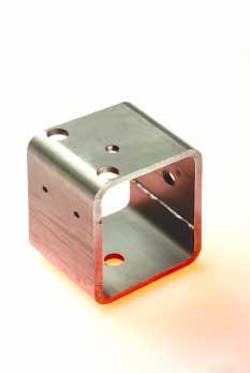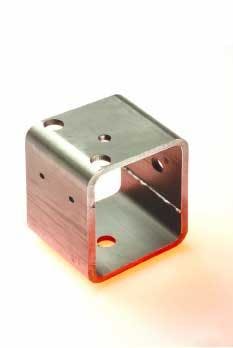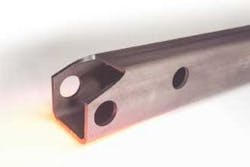Rejuvenating tube cutting business
Since 1985, Production Cutting Services (East Moline, IL) has been processing tube, pipe, and structural steel. Bill Duy, company president and one of the founders, will tell you his company supplies tubular components to manufacturers on a planned delivery schedule. He and three partners started a saw cutting operation, primarily serving three local distributors of tubular products, cutting parts from large sections, essentially making small piece parts out of 40-foot sections. Their East Moline location meant that by 1987 the company was doing work for leading agricultural equipment manufacturers. The partners realized they needed to expand capability with some value-added processes so they purchased drilling equipment and eventually some computerized machining centers in 1989.
Drilling tubes, depending on wall thickness, has always been a production problem. Holding hole tolerances and shapes is difficult—like when you try to mechanically drill a perfectly round hole in a soda can. So a better means to produce holes, preferably non-contact, came under consideration, and eventually the company purchased a plasma cutting system that allowed them to cut wall thicknesses up to 3/4 inch, a process that is still used today in addition to conventional drilling and machining.
But this left the problems with thinner wall thicknesses, and laser cutting started to look like a solution. One day a salesman walked into the plant and handed Bill a sales brochure on Mazak's (Schaumburg, IL; www.mazaklaser.com) laser tube cutting equipment. It was a bit of serendipity because he had been looking in that direction. Over lunch the Mazak approach was presented. Shortly thereafter the company selected a Space Gear U-44 because it seemed to offer the capability needed at an investment cost they could handle, and it looked like the right kind of advanced processing equipment to get started on.
This unit was installed in February last year and, after a learning process, is now up and running two shifts per day turning out tubular components, primarily for six different agricultural equipment plants. Bill points out that agricultural equipment manufacturers and their suppliers can represent up to 80 percent of Production Cutting Services work. Currently they are running three shifts per day, five days per week, a schedule that means 2004 will show a 15 percent increase over 2003 business, which was also up 15 percent.
Like many other shops, the addition of laser cutting capability brought new customers and pleasant headaches. Work for existing customers has the company flat out right now, so the time to work out cutting programs for new customers is limited. However, Duy recognizes the 3D laser as a way to diversify the customer base for those future occasions when the agricultural equipment business cycles downward. In fact, within the foreseeable future the company will be looking to expand its laser cutting capability to meet a projected expanded customer base. This will likely mean a larger capacity unit.
Laser tube cutting is on the cusp of serious growth in the United States, even though many of the purchasing agents and engineers Production Cutting Services calls on are unaware of the technical and economic advantages of the process and the benefits that can occur in better part design and assembly procedures. Duy cites recent examples such as a piece part for farm equipment (see Figure 1) made from 4-inch × 4-inch, × 0.250-inch wall thickness tubing that contains holes that must be held to within 0.010 inch tolerance. Formerly mechanically drilled in four setups per piece and then deburred, the process was time consuming, labor intensive, and required close attention by the machine operator. In addition, debris from the previous process could cause clamping difficulties with the operator manually removing chips each time the part was rotated. And any vibrations from drill to tube contact could produce burrs and affect hole accuracy.
With the Mazak 3D rotary laser, the operator places a 10-foot tube in a chuck and the laser is programmed to cut the right hole in the right face automatically without burrs and debris. The laser's non-contact cutting process eliminates part vibration, and consequently holes are held to tight tolerances. The end result is a 40 percent savings in process cycle time and a superior part made ten times faster.
Another part (see Figure 2) requires a beveled cut to be made on a tube with holes cut on three sides. Originally the part was sawn to length and the three holes were produced, two by drilling through the tube so the top and bottom holes lined up. Then the tube was unchucked and rotated so that four more holes could be drilled. Next, in another machine setup, burrs were removed, inside and outside.
Now the tube is placed in the laser's rotary chuck and done in one setup The extra step needed to bevel cut the end has been eliminated because the laser can do it automatically. The result is a reduction from four steps to one and a 50-60 percent reduction in cycle time.
Duy points out that the more they work with the 3D laser cutter the more advantages they see that can be passed on to their customers in terms of a better part at an attractive price. Because he came out of the tubing industry and has an extensive background working with this material, he is able to conceive of better ways to employ tubing for his customers. As a result the company is frequently called into consultations on future projects where they are able to offer guidance to engineers planning a new part. Counting on the capabilities of a 3D laser, for example, engineers can design slot and tab and other self-locating features that will save time and money on fixturing, welding, and assembly. In addition, they can design parts that are structurally stronger because they are fabricated from tube instead of bent and welded sheet.
Back in 1997 sales at Production Cutting Services were at a record high, then the problems in the agricultural equipment market took their toll on business. For the past two years the company, housed in a 75,000-square-foot building equipped with two overhead cranes to move heavy tubing around, has climbed back almost to the 1997 sales level, but interestingly has done it with about half the people. The implication, although not specifically stated, is that the fast, flexible laser cutter is a major contributor.
The company is looking forward to a prosperous new year and greater diversification in its customer base aided in great measure by the laser cutter.


